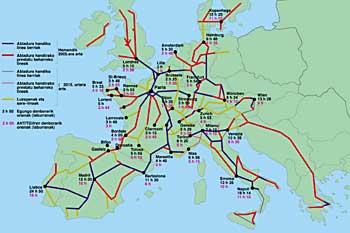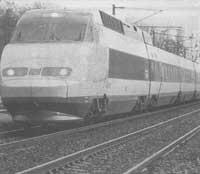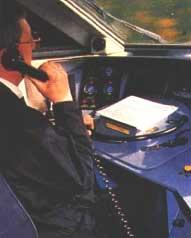European high-speed rail network
1991/03/01 Sarriegi Eskisabel, Andoni Iturria: Elhuyar aldizkaria
At the beginning of the last decade (1981), the Paris-Lyon line began to circulate at 260 km/h. In the end (24-09-1989) Nantes and Rennes were placed 2 hours (similar speed) from Paris. Last year it spread to Aquitaine, placing Bordeaux 3 hours from Paris and leaving Iparralde 5 hours. AHT/ /TGV Atlantic, faster than the previous (Mediterranean). Expansion has begun, and it seems that if things go normally, borders also begin to pass.
In a previous issue (Elhuyar 41), I spoke of the PTF carried out by RENFE in the Spanish State and the Greek Y or H proposed by the Basque Government. The year 2000 is also the first goal and goal close to everyone.

The idea is that Europe is chained by iron for high-speed vehicles on lanes. On the railways, the Twelfth Europe will be with fourteen participants from the starting point. L’Union Internationale des Chemins de Fer (UIC) integrates the twelve EEC States, Switzerland and Austria. In addition, East Germany, until now classified as Oriental, will also be included with Remote Germany. Fifteen days therefore, fourteen.
Fourteen fourteen
The previous appointment of the network was held in January 1989 in a publication entitled Brusselan Propositions pour un réseau européen à grande vitesse. From the projects carried out by State, three main stages have been planned for the coming years. The first two are between 1.995 and 2.005 and the third grand avenir, which have not dared to give deadline.
These three actions are considered necessary for the construction of new railways in 19,000 km and for the conditioning of the old 11,000 km linking Glasgow, Athens, Copenhagen, Lisbon, Berlin and Madrid. However, to get that image still only drawing (see map) there are black spots and concerns like crossing the Alps in the North of Italy. The first performance of all this, already started with the AHT/TGV Atlantic and followed by the AHT/TGV of the North, will be the backbone of the axes Paris-London and Paris-Brussela-Colonia-Amsterdam.
The German Federal Republic has already made part of the 4,500 km of lines planned in the project at high speed. The Italians, since 1.97, are operating 122 km through the distettissim between Rome and Florence, the core of their network of 1,200 km. In Spain there are haste, but they have many problems to adapt their network to European standards.
Among other things, they have the problem of the interrail distance (as in the Basque Country South), from the current 1.672 mm to the 1.435 mm, that those who operated in Spain during the past century, with the military pressure and the fear that Napoleon III invaded, built iron lines of different rank. The PTF project, approved by the Government of Madrid in 1988, mentioned on the other day (Elhuyar 41), is planned to build 2,750 km of new lanes from now to 2,000 years.
On the other hand, and despite the paradox of history, Britain, founder and pioneer in rail matters, continues. The TAV/TGV of the North must be formed from 1.993 with leaving the tunnel of La Mancha and move to London at a speed of 100 km/h, undoubtedly, until the year 2000.
But, what kind of train will rotate to circulate at high speed on these lanes? The technological competence is not ruled out of course with a perspective of convergence and association. The Frenchman AHT/TGV is the fastest, being exploited and going ahead of others, despite trying to catch Germany and Japan from behind. The material of the north line should be at a speed of 320 km/h and the Germans are also present, both with the manufacture of ICE (Inter Cyti Express), manufactured by the consortium Siemens-Krupp-AEG, as with any other type of material of its industry.
Its current prototype of Transrapid has reached a speed of 406.9 km/h (Brand 1.988). However, in the commercial service it is designed to circulate at 250 km/h, but this German machine is more clumsy than the French one. A load of 20 tons per axis makes the limit of the European project to exceed 3 tons. Thus, the ICE, in train mode, only passes 160 km/h in forced form. A more “agile” version is now being studied.
On the other hand, very high speeds are not exploding as much as in France. The same happens to the Japanese, who cannot refuse to sell their vehicles in Europe, but in the exploitation they have not advanced as much as SNCF. In addition, one of the biggest breakdowns is not the case of conventional rail, levitation, etc. But. The future may be yours, but today it seems that the traditional path will continue, even if it is full of beacons facilities and other aid tools.
Italy is also involved with the FIAT METRO. 6 Model 450 branches run from one year to 250 km/h, but model 500 (still in prototype) should run at 300 km/h. The UIC is very concerned about unity. This is still theoretical and in his report on circulating material for the project of the European chain, says it will be difficult and expensive. In addition, the concerns of each State are enormous so that the materials circulate above the limits and there are technical limitations such as electric power, signaling system and telecommunications.
This process can also present cushioning. Current rules indicate that the train must be driven by the “national driver” and when the limit passes the driver changes. Europe still has many border problems to solve.
And Euskal Herria is also in Europe
Once again, Euskal Herria is a mandatory step and the TAV has to pass through here sometime. However, this pass should not be a mere “pass”. If so, we would do nothing more than a good tunnel or bridge for Europeans. If anything were, at least you would have to meet some requirements and in this doing it quickly and quickly is worth as much or more, well and correctly. Without removing space from others, you should meet at least the following requirements:
- Establish and execute the service and design of the connection and association of the main capitals and population nuclei of the Basque Country (North and South).
- Communicate easily to all the countries of the Basque Country with other European countries.
- In the exploitation of this new railway network, getting our power to be the maximum responsible for the local network.
- Getting the control of the transport that is going to pass through there is able to exercise its powers.
I believe that these conditions can be demanded by any people or nation in the world and that Euskal Herria also has to try to fulfill them. Geroa will say if the railway for the High Speed Train will go to the development, unity and social, cultural, economic and sovereign progress of the Basque Country or contribute to its disappearance. Now, how they are posed and made or left to be done, so will the future be.
At least once in history, how are we going to do things in this field?


Gai honi buruzko eduki gehiago
Elhuyarrek garatutako teknologia






